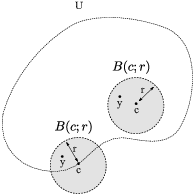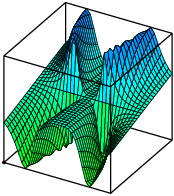I'll give the precise definition of a limit so that you can see the
similarity to the definition you saw in single-variable calculus. The
first definition is a technical point which you don't need to worry
about too much. It simply ensures if we take a limit as ![]() , that x can approach c through a set where the
function is defined.
, that x can approach c through a set where the
function is defined.
Definition. Let U be a subset of ![]() . A point
. A point ![]() is an accumulation point of U if for every
is an accumulation point of U if for every ![]() , the open ball
, the open ball ![]() contains a point
contains a point
![]() other than c.
other than c.
![]() is the set of points in
is the set of points in ![]() which are less than r units from c:
which are less than r units from c:
![]()

Definition. Let ![]() be a function defined on
be a function defined on ![]() , and let c be an accumulation point of U.
Then
, and let c be an accumulation point of U.
Then ![]() means:
means:
For every ![]() , there is a
, there is a ![]() , such that
, such that
![]()
Many results you know about limits from single-variable calculus have analogs for functions of several variables.
Proposition. Suppose ![]() where
where ![]() . Let c be an accumulation point of U, and
let
. Let c be an accumulation point of U, and
let ![]() . Then:
. Then:
(a) ![]() .
.
(b) ![]() .
.
(c) ![]() .
.
(d) ![]() ,
provided that
,
provided that ![]() .
.
All of these results mean that if the limits on the right side are
defined, then so is the limit on the left side, and the two sides are
equal.![]()
I won't try to state all of the easy results on limits that generalize to functions of several variables. You will see many of them proven in a course in real analysis. Let's look at some of the complications that result from being able to approach a point in more than one dimension.
Example. Compute ![]() .
.
I can compute the limit by plugging in. (This is another way of
saying that ![]() is
continuous at
is
continuous at ![]() .) Thus.
.) Thus.
![]()
Example. Compute ![]() .
.
I can compute the limit by plugging in.
![]()
Example. Compute ![]() .
.
Substituting ![]() yields the indeterminate
form
yields the indeterminate
form ![]() .
.
Here's the graph of the function. Notice that as ![]() the height seems to approach one value
along the "ridgeline" while it approaches another value
along the "valley":
the height seems to approach one value
along the "ridgeline" while it approaches another value
along the "valley":

This leads me to believe that the limit is undefined.
To prove this, I try to find different ways of approaching ![]() which give different limits. Specifically, I try to
pick different curves through
which give different limits. Specifically, I try to
pick different curves through ![]() which make
which make ![]() simplify to different
values. In this case, I try the x-axis, which is
simplify to different
values. In this case, I try the x-axis, which is ![]() , and the y-axis, which is
, and the y-axis, which is ![]() .
.
Set ![]() and let
and let ![]() . I have
. I have
![]()
Set ![]() and let
and let ![]() . I have
. I have
![]()
Since ![]() approaches
different numbers depending on how
approaches
different numbers depending on how ![]() approaches
approaches ![]() , the limit is
undefined.
, the limit is
undefined.![]()
Example. Compute ![]() .
.
Substituting ![]() yields the indeterminate
form
yields the indeterminate
form ![]() .
.
Here's the graph of the function. It is a little harder to tell from the graph what is happening near the origin.

It turns out that the limit is undefined. To show this, I'll approach
![]() along a line and along a curve.
along a line and along a curve.
If you approach ![]() along the line
along the line ![]() , you get
, you get
![]()
Next, I notice that ![]() and
and ![]() . Thus, I can get multiple "
. Thus, I can get multiple "![]() " terms by setting
" terms by setting ![]() .
.
If you approach ![]() along the curve
along the curve ![]() , you get
, you get
![]()
Since ![]() approaches
different numbers depending on how
approaches
different numbers depending on how ![]() approaches
approaches ![]() , the limit is
undefined.
, the limit is
undefined.![]()
Example. Compute ![]() by converting to polar coordinates.
by converting to polar coordinates.
Let ![]() and
and ![]() . Then
. Then
![]()
Then
![]()
Example. Compute ![]() .
.
I try to find different curves through ![]() which make
which make ![]() simplify to different values.
simplify to different values.
If you approach ![]() along the line
along the line ![]() ,
, ![]() , you get
, you get
![]()
If you approach ![]() along the line
along the line ![]() , you get
, you get
![]()
Since you get different limits by approaching ![]() in different ways,
in different ways, ![]() is undefined.
is undefined.![]()
Definition. Let ![]() , where
, where ![]() , and let
, and let ![]() . Then f is continuous at c if
. Then f is continuous at c if
![]()
Remark. Some authors will say a function ![]() is not continous at a point where
the function isn't defined. For example, the function f defined by
is not continous at a point where
the function isn't defined. For example, the function f defined by
![]() has (natural) domain
has (natural) domain ![]() . These authors will say that f is not continuous at
. These authors will say that f is not continuous at
![]() , with similar terminology for
multivariable functions. I'll avoid doing this: It seems
inappropriate to talk about whether a function does or does not have
a property like continuity at the point where there is no function!
, with similar terminology for
multivariable functions. I'll avoid doing this: It seems
inappropriate to talk about whether a function does or does not have
a property like continuity at the point where there is no function!
I'll only consider continuity (or lack of continuity) at points in a function's domain.
Example. A function ![]() is defined by
is defined by

Is f continuous at ![]() ?
?
![]()
However, ![]() ,
,
Since ![]() , it follows that f is not continuous at
, it follows that f is not continuous at ![]() .
.![]()
Copyright 2018 by Bruce Ikenaga